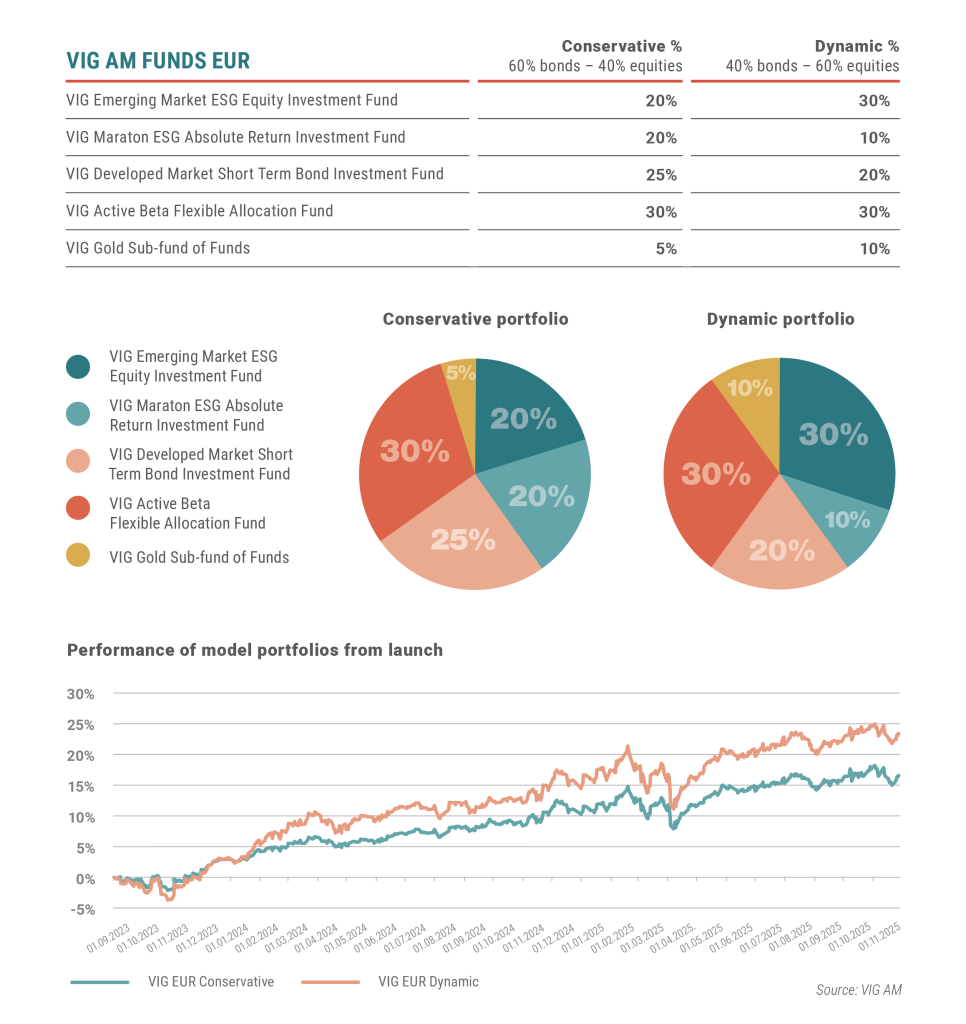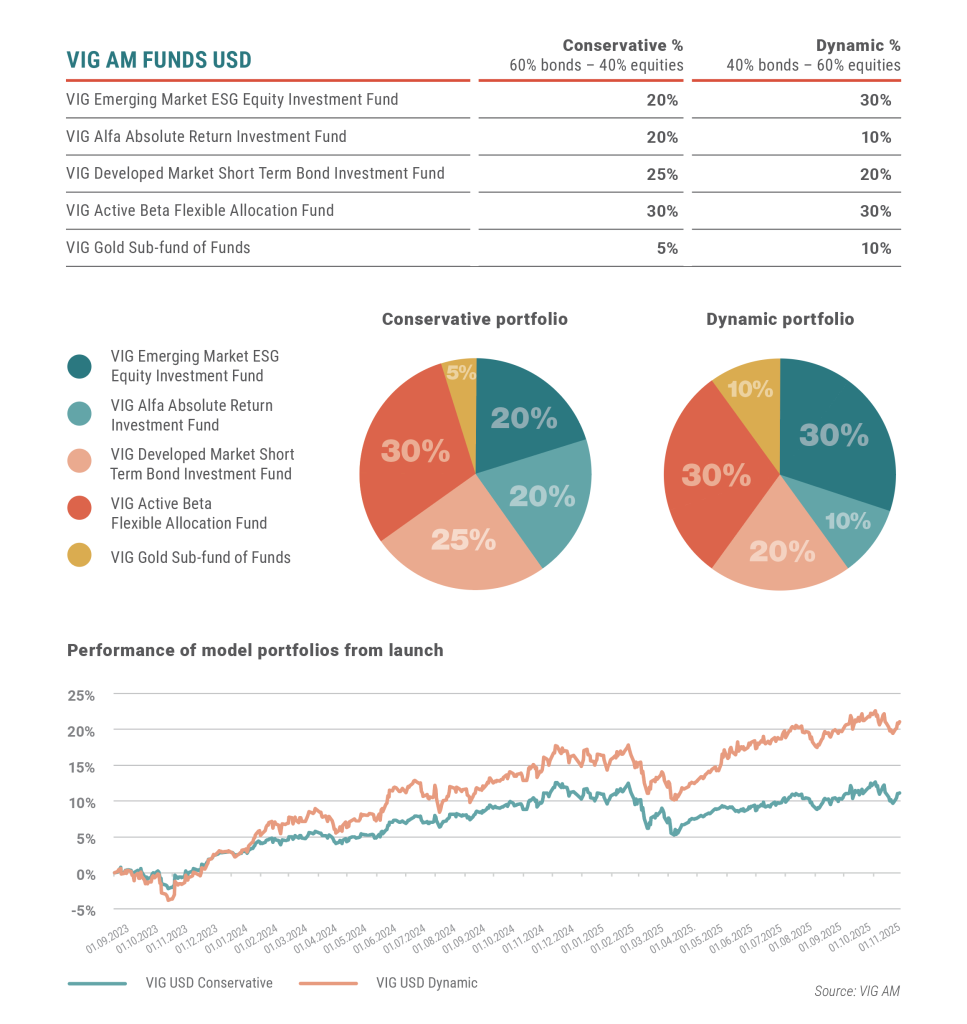The model portfolios have been constructed based on the VIG Investment Clock and our tactical asset allocation strategy, using following principles: we have selected 4-5 investment funds from our own range.
In all three currencies, the Conservative Portfolio targets a composition of 40% equities and 60% bonds, while the Dynamic Portfolio focuses on 60% equities and 40% bonds.
The key economic factors behind these allocations include global and regional economic trends, expectations of central bank interest rate cuts, and investor sentiment.
Conservative portfolio focuses more on stability and fixed income assets (bonds), whereas dynamic portfolios aim for higher-yield outlook, using the volatility of equities. ESG considerations remain important, particularly in emerging markets and mixed-asset funds.
Investment Approach
Equity markets remain attractive despite short-term risks
We continue to see strong potential in equities, which, while carrying higher risk, also offer superior return prospects. Following the modest correction in November – which we flagged in our previous monthly newsletter – equity markets quickly regained momentum. By early December, the S&P 500 Index, which tracks the average price performance of the largest companies listed on the New York Stock Exchange, was once again close to a 20% year-to-date gain.
Corporate earnings remain solid, and investor sentiment has been further supported by expectations that the U.S. Federal Reserve may stimulate the economy through interest rate cuts. For now, the effects of the U.S. “tariff war” have yet to materialise in economic data, although an increasing number of research institutions are warning of potential longer-term consequences. According to estimates by the European Commission, these measures could reduce U.S. GDP by 0.6-1% over time. Against this backdrop, diversification remains a key tool for risk mitigation.
Positive growth outlook supports equities and commodities
According to our proprietary business cycle model, the VIG Investment Clock, growth prospects across the major global regions remain favourable. This environment continues to support equity markets and commodity investments in particular.
Artificial intelligence remains the dominant investment theme on equity markets, although the enthusiasm has become more selective than in earlier phases. Investors are now paying closer attention to fundamentals, triggering a notable rotation within the sector. One of the key beneficiaries of this shift has been Google, which has emerged as a serious challenger to Nvidia: Google’s shares gained nearly 20% in November, while Nvidia’s stock declined despite strong third-quarter earnings.
Emerging market equities also offer compelling return potential. GDP growth rates that are two to three times higher than those of developed markets, combined with a weaker U.S. dollar and the possibility of easing geopolitical tensions, create a supportive environment for rising asset prices.
Bonds face headwinds, with Hungary as a notable exception
A strengthening economic cycle, however, is generally less favourable for bond markets. In an environment of solid growth, central banks are under less pressure to cut interest rates, limiting the potential for significant price appreciation in fixed income assets.
One notable exception may be Hungary. Following the sell-off triggered by the announcement of a higher-than-expected budget deficit, forint-denominated bonds have repriced sharply. Given the relative stability of the forint and the fact that major international credit rating agencies have not materially downgraded Hungary’s sovereign rating – despite maintaining a negative outlook due to weak fiscal discipline and deficit reduction efforts – current yield levels may present an attractive entry point.
With long-term yields above 7% and a meaningful real interest rate, Hungarian government bonds could offer compelling value for long-term investors willing to accept the associated risks.
VIG EUR Portfolios
In order to enhance the portfolio’s return potential, we implemented changes to our euro-denominated, higher-risk “Dynamic” model portfolio, in line with prevailing market trends.
As in the previous month, we increased the allocation to the VIG Active Beta Flexible Allocation Fund, which invests in the most popular and widely publicised U.S. and European listed equities, while maintaining a disciplined and robust risk-management approach. The fund focuses on companies with the strongest market narratives – those that have captured both investor attention and media interest.
At the same time, we reduced the weight of the VIG Developed Markets Short Term Bond Investment Fund, reflecting a deterioration in the global outlook for bond markets.

VIG USD Portfolios
We implemented similar tactical allocation changes in our U.S. dollar–denominated model portfolio as in the euro-based version.
Within the higher-risk, return-seeking “Dynamic” allocation, we once again increased the weight of the VIG Active Beta Flexible Allocation Fund in order to further enhance return potential. The fund invests in the most popular U.S. and European listed equities while applying a disciplined and robust risk-management framework, focusing on companies with the strongest market narratives and media attention.
At the same time, we reduced the allocation to the VIG Developed Markets Short Term Bond Investment Fund, reflecting the weakening global outlook for bond markets.

Disclaimer
This is a distribution announcement. Detailed information is needed to make a well-founded investment decision. Please inform yourself thoroughly regarding the Fund’s investment policy, potential investment risks and distribution in the Fund’s key investment information, official prospectus and management regulations available at the Fund’s distribution outlets and on the Asset Management’s website (www.vigam.hu). The costs related to the distribution of the fund (buying, holding, selling) can be found in the fund’s management regulations and at the distribution outlets. Past returns do not predict future performance. Please note that in comparison with other investment funds, the return achieved may be affected by differences in the reference index and therefore the investment policy.
The future performance that can be achieved by investing may be subject to tax, and the tax and duty information relating to specific financial instruments and transactions can only be accurately assessed on the basis of the individual circumstances of each investor and may change in the future. It is the responsibility of the investor to inform himself about the tax liability and to make the decision within the limits of the law.
The information contained in this leaflet is for informational purposes only and does not constitute an investment recommendation, an offer or investment advice. VIG Asset Management Hungary Closed Company Limited by Shares accepts no liability for any investment decision made on the basis of this information and its consequences.
The Asset Management’s license number for managing alternative investment funds (AIFM) is: H-EN-III-6/2015. The Fund Manager’s license number for UCITS fund management (collective portfolio management) is: H-EN-III-101/2016.